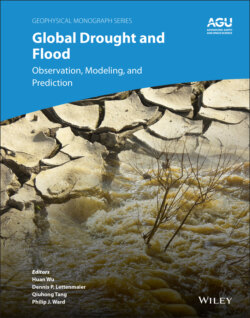Читать книгу Global Drought and Flood - Группа авторов - Страница 36
2.4. DROUGHT MONITORING PRODUCT SYSTEM BASED ON ET REMOTE SENSING 2.4.1. Theoretical Description of ET and Drought Monitoring Product System
ОглавлениеMonitoring ET and the extent and severity of agricultural drought is an important component of food and water security and world crop market assessment. Currently, no spatially distributed land surface ET product is available routinely from satellite observations. The GOES thermal observation based ET product is in high demand by the National Center for Environmental Prediction (NCEP) for validating Noah land surface model output and satellite based drought data product for monthly drought briefing. Moreover, ET/drought information is greatly needed in the U.S. Department of Agriculture (Foreign Agricultural Service/National Agricultural Statistics Service/Agricultural Research Service) for world crop forecasts and United States agricultural production monitoring. Since the GOES data are operationally available within NESDIS, generating ET and drought data products via the ALEXI model will meet the data needs by NCEP groups and other users. Under the circumstances, the GET‐D product system is designed to generate ET and drought maps operationally.
The ALEXI model computes the principle surface energy fluxes, including ET, which is a critical boundary condition to weather and hydrologic modeling, and a quantity required for regional water resource management. The ALEXI model ET estimates have been rigorously evaluated in comparison with ground‐based data, and perform well over a range in climatic and vegetation conditions. Evapotranspiration deficits in comparison with PET rates provide proxy information regarding soil moisture availability. In regions of dense vegetation, ET probes moisture conditions in the plant root zone, down to meter depths. A simple ESI can be developed from the ALEXI model flux estimates. Anderson et al. (2007, 2011) have demonstrated that the ALEXI model ESI over the continental United States shows good correspondence with standard drought metrics and antecedent precipitation, but can be generated at significantly higher spatial resolution due to a limited reliance on ground observations. As a diagnostic indicator of actual ET, accounting for both precipitation and nonprecipitation related inputs to the plant‐available soil moisture pool (e.g., irrigation, shallow groundwater), the ESI is a measure of actual vegetation stress rather than potential for stress. Because precipitation is not used in construction of the ESI, this index provides an independent assessment of drought conditions and will have particular utility for real‐time monitoring in regions with sparse rainfall data or significant delays in meteorological reporting.
